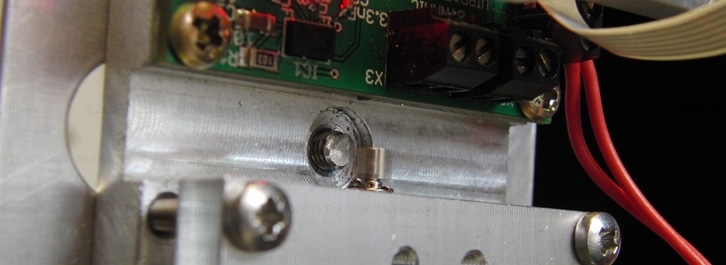Using Normalised Vibration Amplitudes
We present the vibration amplitude of our vibration motors and linear resonant actuators in G. You can see how the vibration amplitude varies with the input voltage on the Typical Performance Characteristic graphs.
However, there is a slight problem when it comes to directly comparing the results from testing the vibration strength of our motors, which we can share with a little insight into the test process.
The unit under test (UUT) is attached to a vibration sled – a metal block with a known mass. Our vibration amplitude testing machine varies the applied voltage to the vibration motor, and an accelerometer on the sled measures the resulting G.
Accelerometers, due to their construction, have a maximum G that they can measure. Some of our larger motors would produce more than enough vibration to overload the accelerometer, resulting in clipping and inaccurate results.
To combat this we use test sleds of different mass. Imagine applying the same force to a much heavier object, the resulting acceleration (G-force) is greatly reduced – thanks to Sir Issac Newton:
$$F = m \times a$$
So now we can accurately measure our entire product line. However, the results are not measured under the same test conditions and we, therefore, cannot directly compare them.
Enter Typical Normalised Vibration Amplitude. This figure shows how much vibration amplitude is created when the motor runs at its rated voltage relative to a 100g target mass. It is a simple calculation:
$$Normalised \: Vibration \: Amplitude = \frac{Test \: Sled \: Mass \: (g)}{100} \times Vibration \: Amplitude$$
And it allows us to directly compare the vibration motors. It makes it possible for you to compare motors against each other, regardless of their power and appropriate test setup.
Please note that the Typical Performance Characteristics graph uses the non-normalised results, but you can find the Inertial Test Load in the datasheet for reference.


Get in touch
Speak to a member of our team.
Motor catalogue
Looking for our products?
Reliable, cost-effective miniature mechanisms and motors that meet your application demands.
Discover more
Resources and guides
Discover our product application notes, design guides, news and case studies.
Case studies
Explore our collection of case studies, examples of our products in a range of applications.
Precision Microdrives
Whether you need a motor component, or a fully validated and tested complex mechanism – we’re here to help. Find out more about our company.